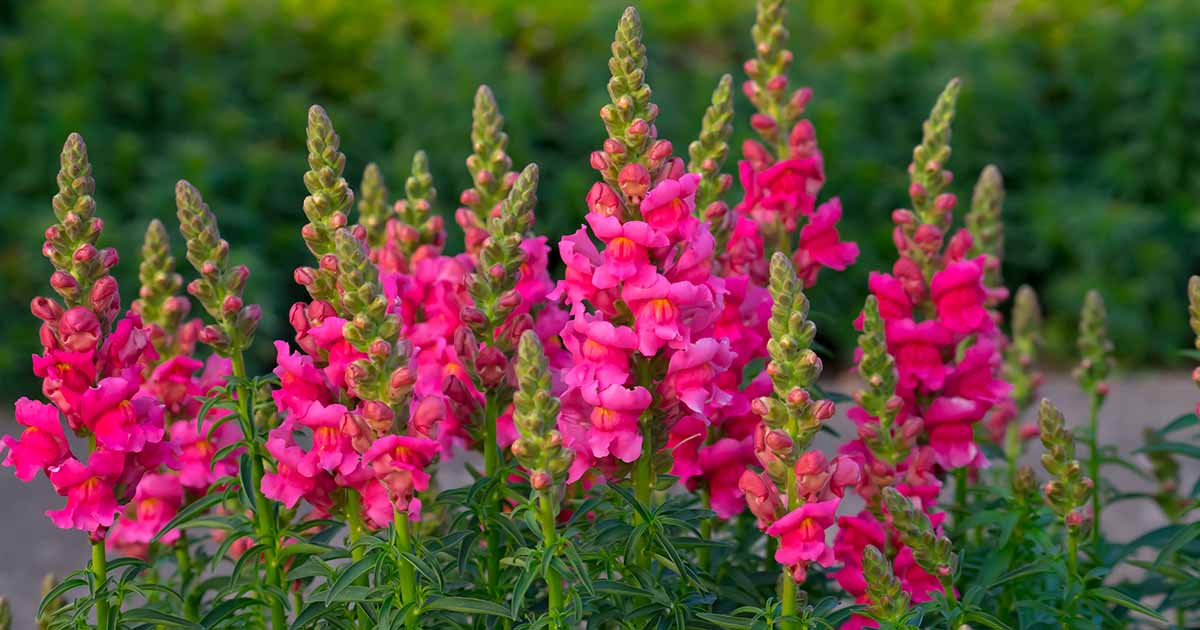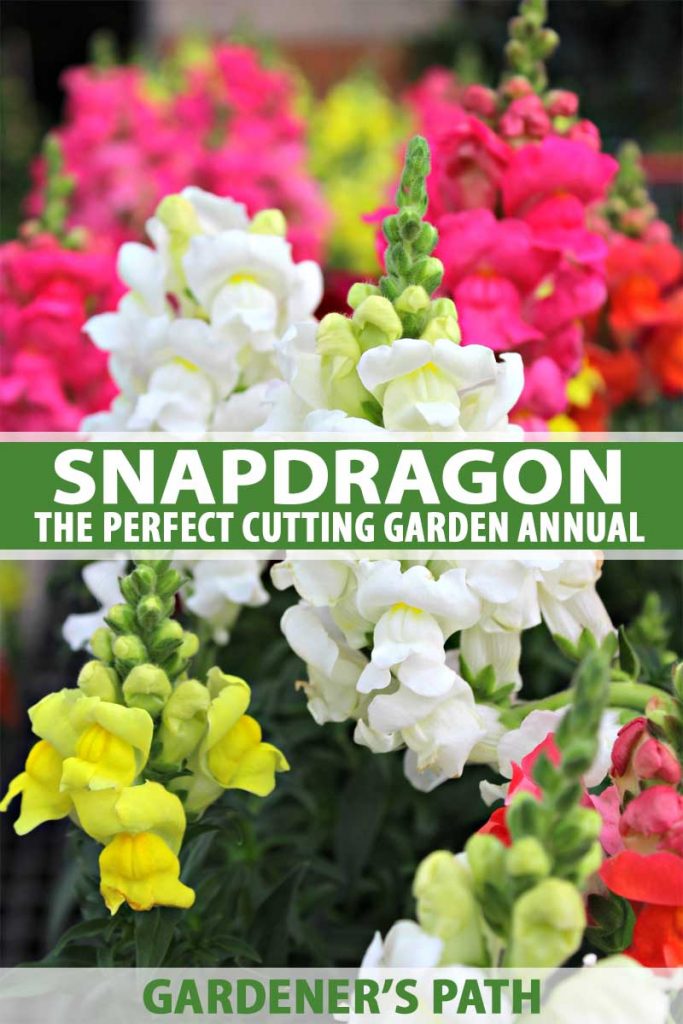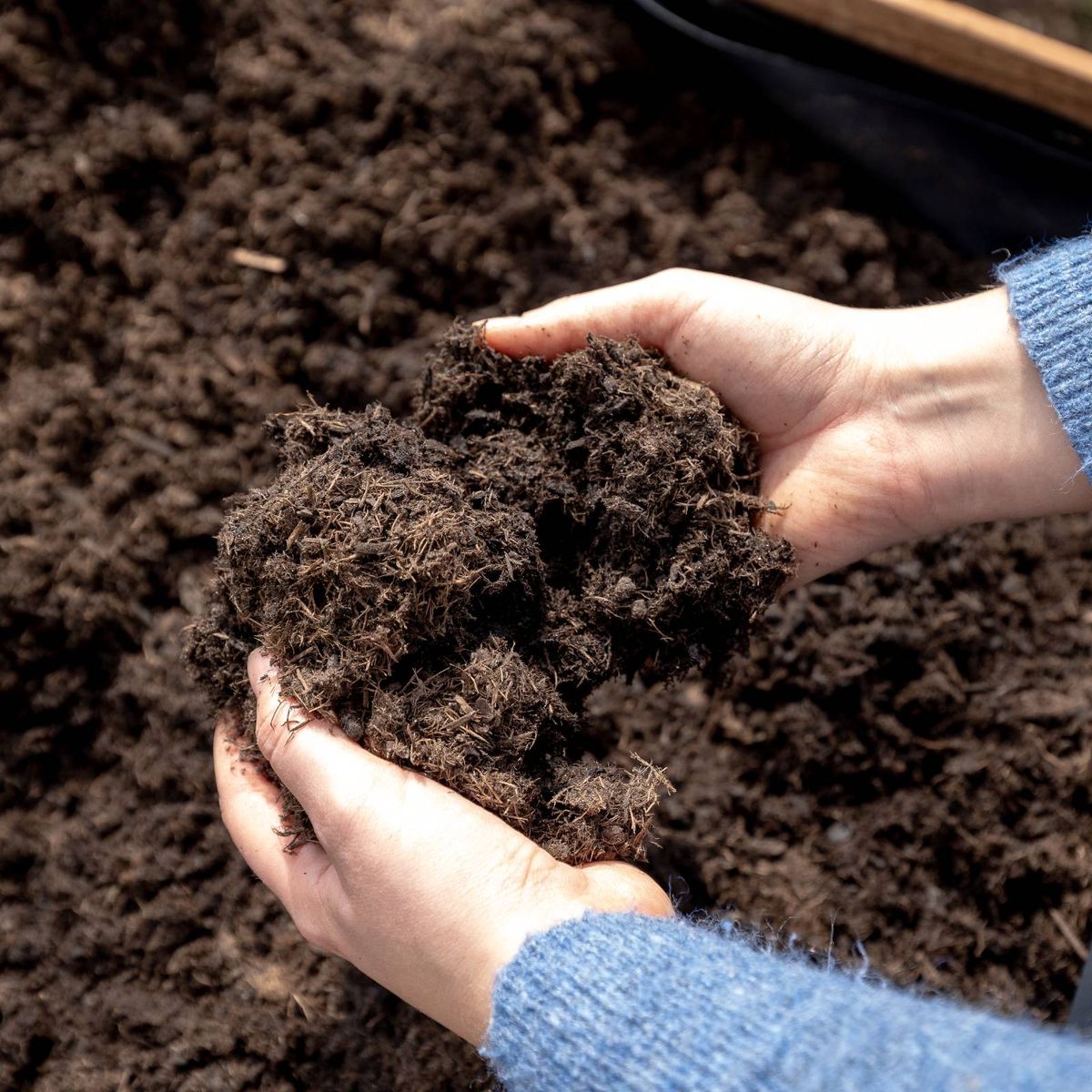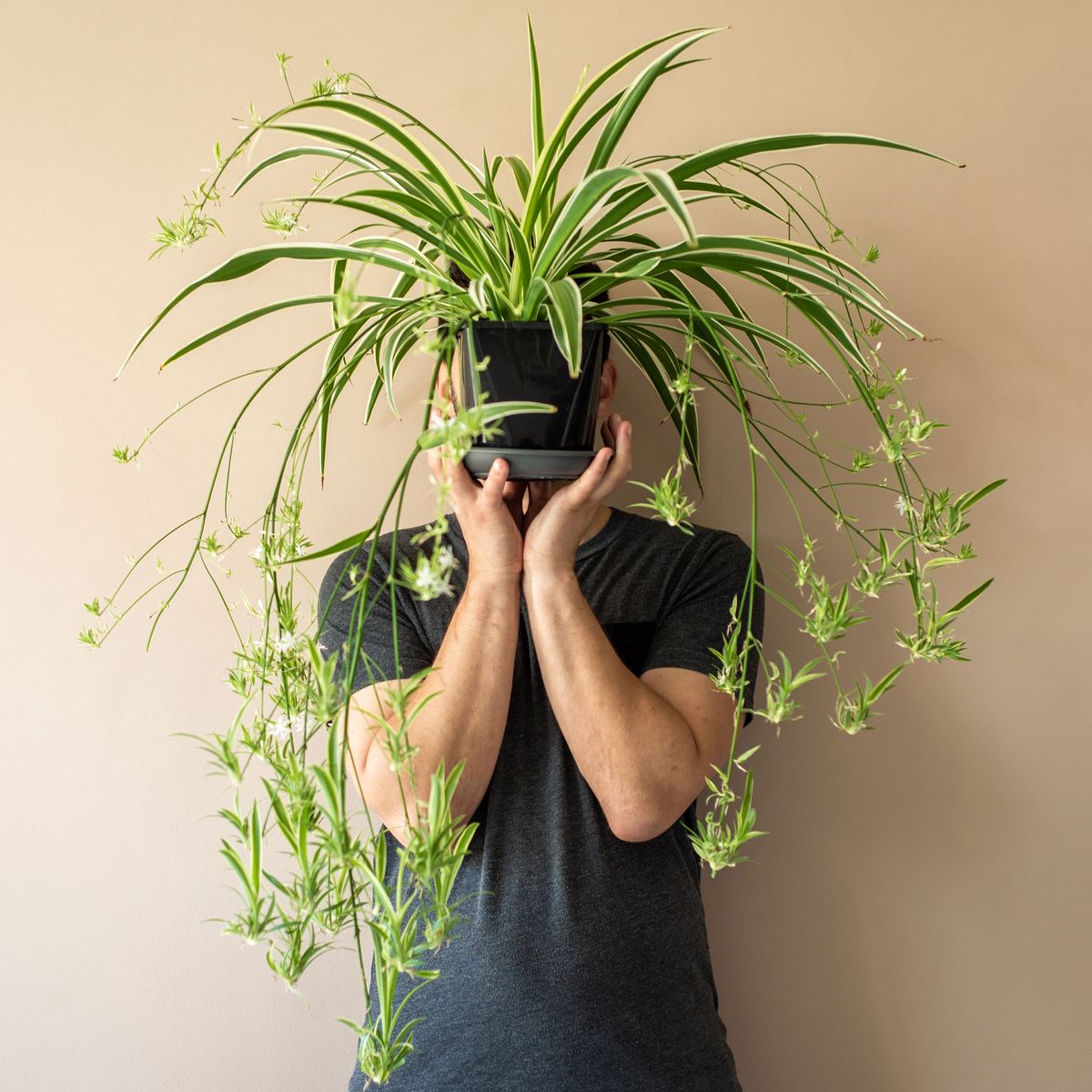Antirrhinum majus
Snapdragon, Antirrhinum majus, is native to Mediterranean Europe. Its common name comes from the pinchable blossoms that open and close like the mouths of friendly dragons.
It is a cool-weather plant that grows as a tender perennial in USDA Hardiness Zones 7 to 10, and as an annual in other temperate regions.
A. majus is the “type species,” or benchmark plant, in the Antirrhinum genus. There are approximately 20 species in the genus, including some from North America and northern Africa.

We link to vendors to help you find relevant products. If you buy from one of our links, we may earn a commission.
The Antirrhinum genus a member of the Plantaginaceae, or plantain, family, which is a sub-group of the expansive Scrophulariaceae, or figwort, family of plants, some of which you may already know.
One is toadflax, Linaria vulgaris, aka butter and eggs, a common sight along country roads. It, too, has flowers with a hinged-style “mouth.”
Other members of this large plant group have stationary mouths, like summer snapdragon, A. angustifolia; beardtongue, Penstemon; wishbone flower, T. fournieri; and foxglove, Digitalis.
Classic characteristics of figwort family members are their squarish stems, and upright spikes of open-lipped blossoms.
In this article, you’ll find all you need to know to grow snapdragon, A. majus, in your garden.
Let’s get started!
Cultivation and History
Snapdragon thrives in the cool, late spring to early summer portion of the growing season. Once temperatures hit around 80°F, it loses vigor.
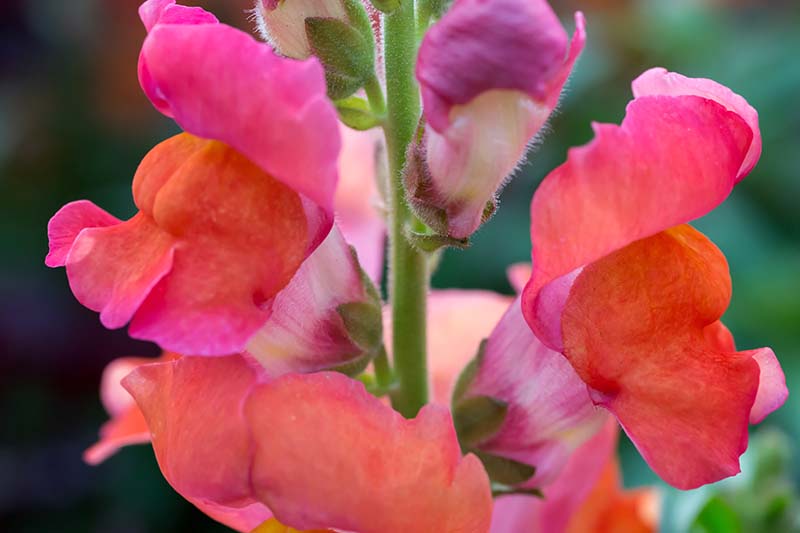
In the garden, snapdragon has much to offer. There are three sizes from which to choose:
Dwarf varieties range in height from eight to 12 inches, intermediates from 13 to 24 inches, and tall from 25 to 36 inches.
Mature widths range from six to 12 inches.
And the colors!
Thanks to extensive hybridization by plant breeders, an array of disease-resistant varieties are available in hues including orange, peach, pink, purple, red, white, and yellow. There are also many exciting bicolor and tricolor combinations. The only color you won’t find is true blue.

A. majus has a clumping growth habit, upright squarish stems, and lance-shaped green leaves.
Flower buds along the stems open sequentially from the bottom up to the terminal tips.
Deadheading the spent flower stems, as well as cutting stems for vase use, prolongs blooming in cool regions.
In warmer areas, a midseason cutback to six inches or so may encourage plants to re-foliate and produce a second, late-season bloom.
After blooming, flowers set seed. Those of cultivated varieties may or may not be viable, and are not likely to replicate the traits or quality of parent plants.
The botanical name Antirrhinum majus comes from the Greek. “Anti” means like, and “rhis” means snout. It’s an apt description of a “bilabiate,” two-lipped, flower that resembles a dragon’s mouth.
Ancient Greeks and Romans believed the flowers were endowed with mystical powers of protection, prowess, and beauty.
Early Americans held them in similar regard. Victorians planted them in their cottage gardens, and by the middle of the 20th century, snapdragons had become a widely hybridized garden staple. They remain so today.
Propagation
To grow A. majus, you need to start with disease-resistant seed or nursery plants that you have purchased from a reputable purveyor, or you can propagate them from stem cuttings.
From Seed
In Zones 7 to 10, where snapdragon is a tender perennial, you can pre-seed in the fall for spring blooms.

Alternatively, you can sow seeds directly in the spring. Expect maturity in 80 to 100 days.
To sow seeds outdoors, choose a location that receives full sun. Work the soil to a depth of six to eight inches, until it has a crumbly consistency. Add compost as desired.
Moisten the soil with the gentle spray or mist setting on your garden hose.
Sprinkle the seeds over the soil surface. Ultimately, plants should be six to 12 inches apart, but as the seeds are very tiny, just sprinkle them as best you can, and thin them out later. Thinning is crucial, as air circulation minimizes the risk of raising the humidity and activating fungal spores.
Do not cover the seeds as they need light to germinate. Allow them to be exposed to the sunlight.
Maintain even moisture during germination. Some folks like to use slow drip irrigation to avoid oversaturating the soil.
Once you see two sets of true leaves, thin the seedlings out to six to 12 inches apart, depending on the variety you are growing. Check your seed packet for the expected mature width and thin accordingly.
When the plants are about four inches tall, pinch off the top inch of growth to promote bushier plants.
If you live in other temperate zones, and are growing these plants as annuals, start seeds indoors eight to 10 weeks before the last average frost date. Transplant them to the garden or containers after the danger of frost has passed.
Before you start, you’ll need to chill the seeds for three to five days in the refrigerator to improve germination. Alternatively, after sowing you can place the pots in a cool location of 40-47°F for five days.
Use biodegradable seed starter cells that can be planted in their entirety to prevent any damage to the roots during transplanting.
Fill the cells with moistened potting medium, then sprinkle a few of the very tiny seeds on top. Press them into place, but don’t bury them, as they need light to germinate.
Place the cells in a sunny window or under grow lights. The ideal room temperature replicates the ideal outdoor temperature, and is in the 60° to 79°F range. Warming mats are not recommended, as this is a cool-weather plant.
Mist the potting medium regularly to maintain even moisture, but do not oversaturate.
Seeds generally sprout in one to two weeks.
When the seedlings have one set of true leaves, thin them to one strong seedling per cell.
At this time, you can apply a liquid houseplant food at half strength.
When seedlings are about four inches tall, you can pinch the top inch of the stem off. This prevents leggy growth and produces fuller, multi-branched flower stems.
Continue to keep the potting medium moist, but never soggy.
After the danger of frost has passed, transplant the seedlings to the garden as described below.
From Cuttings
To start new plants from existing ones, you can take a cutting from the growing tip of a mature plant. This is a challenging method
Cut a three- to four-inch section of stem just below a pair of leaves. Snip off the lower leaves to expose about an inch of bare stem, and dip the cut end into powdered rooting hormone.
Place the cutting in a sterile potting medium in a location with a temperature of 65-75°F. Bottom heat is not recommended.
Keep the potting medium moist, but not waterlogged.
Some folks like to cover the plant with plastic to mimic a greenhouse, but as these plants are prone to fungal growth, I don’t recommend this.
New growth is evidence of successful root formation and should take two to three weeks.
Transplant the rooted cutting to the garden, keeping it at the same depth it is in the starter container.
From Seedlings/Transplanting
Nursery plants range from seedlings to plants that are budding or in bloom. They are available in the spring and are ready to transplant immediately.
Seedlings started indoors should be hardened off gradually, by placing them outdoors for an increasing amount of time over the course of a week to 10 days.
Work the soil to a depth of six to eight inches and amend with compost. Dig a hole the same size as the container the plant is currently growing in.
Carefully remove the seedling or nursery start from the pot, and place the root ball in the hole the same depth as it was in its current container.
If you are using biodegradable starter cells, plant entire cells so that the top of the medium is even with the ground soil.
Maintain one inch of supplemental water per week in the absence of rain.
How to Grow
A. majus thrives best in a full sun location, with organically-rich, loamy, well-draining soil.
Conduct a soil test through your local agricultural extension to determine the composition of the earth in your garden. The ideal type for snapdragons has a slightly acidic to neutral pH of 6.2 to 7.0.
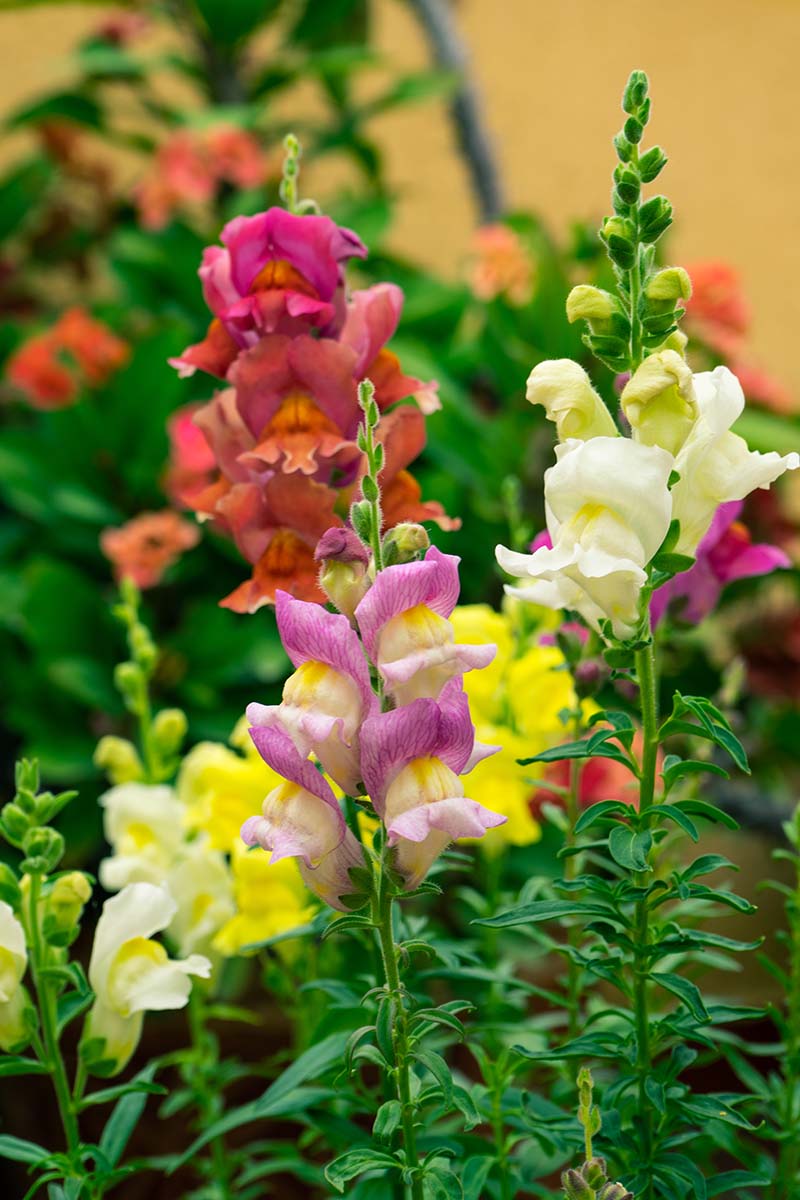
Provide an inch of water per week, in the absence of rain. Not sure how much rain you are receiving? You can use a rain gauge. Water at the soil level, and don’t oversaturate, to keep the leaves dry and fungus-free.
The addition of compost is a great way to enrich the soil, improve drainage, and contribute acidity.
When you see flower buds, it’s time to fertilize.
Sprinkle a well-balanced (10-10-10), slow-release granular product around, but not touching the plants. Water lightly immediately after application.
Regardless of how you start a plant, you have the option of growing it in the garden or in a container.
For container growth, choose a pot with adequate drainage holes.
The diameter must accommodate the mature dimensions of the dwarf, intermediate, or tall plants that you are growing, plus an extra inch for the spout of a watering can or hose nozzle.
Because the roots of A. majus are on the shallow side, a pot with a depth of 12 to 18 inches should accommodate the tallest varieties.
Growing Tips
When planting, keep the following in mind for best results:
- Start seeds indoors in regions with hot summers so plants can bloom before the mercury soars.
- Surface sow seeds to provide light for germination.
- Follow the spacing recommendations to promote air circulation and avoid increasing ambient humidity which can invite fungal growth.
Maintenance
Snapdragons don’t require a great deal of maintenance.
As mentioned, pinching the growing tips promotes bushy growth, deadheading spent flower stems encourages further blooming, and a midseason cutback to a height of about six inches will stimulate a second bloom.
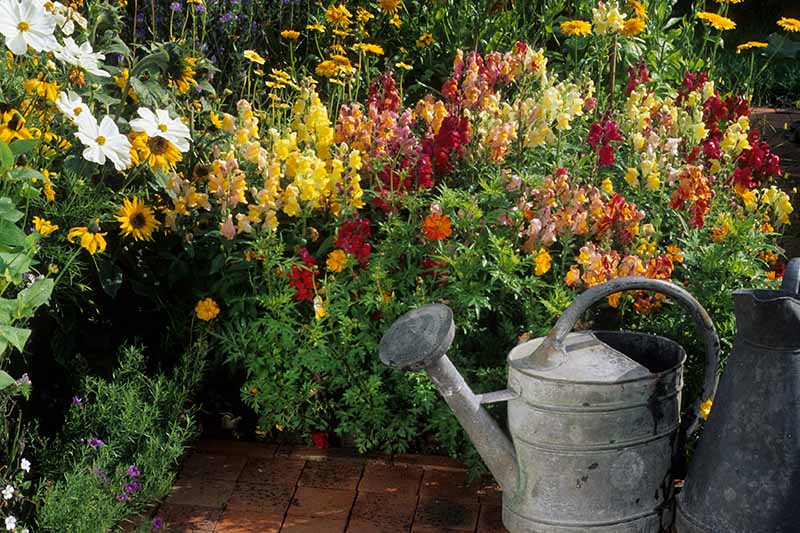
If you live in a cool zone, and your flowers bloom once and then peter out, cut them down to six inches, feed them with a well-balanced, slow-release granular fertilizer, such as 10-10-10 (NPK) and they should perk up.
Other ways to help your plants perform well include weeding the garden regularly to minimize competition for water and reduce the breeding ground for insects and pathogens.
You can also apply a two-inch layer of mulch to reduce weed growth, as well as to keep the ground cool and aid in moisture retention.
When applying fertilizer, be sure to place it near, but not on plants to avoid burning them.
The same goes for mulch. Keep it a few inches away from plant stems to promote air circulation and inhibit fungal development.
At season’s end, remove wilted foliage to prevent the wintering over of pests and pathogens.
Cultivars to Select
Snapdragon hybrids are available in an array of bright, velvety colors as seeds or nursery plants.
Those that say “rust-resistant” are your best bets, as they have been bred to stand up to one of the biggest threats to this species, Puccinia antirrhini, a fungus that causes rust-spotted leaves.
Brighton Rock
‘Brighton Rock’ is an exciting heirloom variety that pollinators love. Enjoy a blend of pastel and bicolored blooms, in shades of red and orange on 36-inch flower stems.
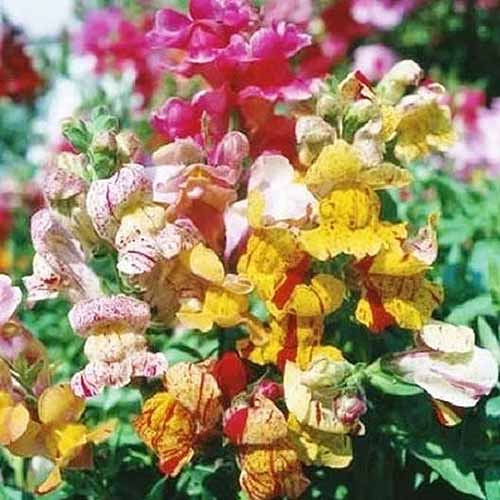
‘Brighton Rock’
You can find seeds in a variety of package sizes available from Eden Brothers.
Magic Carpet
For another beautiful selection, try the ‘Magic Carpet’ mix, in shades of red, pink, apricot, and yellow. This dwarf variety will reach about eight inches in height.
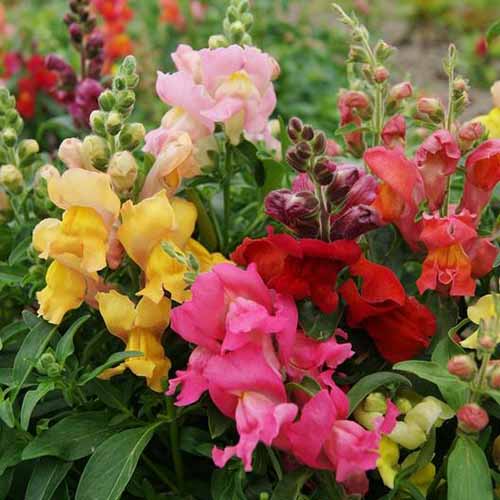
‘Magic Carpet’ Mix
You can find ‘Magic Carpet’ mix seeds available from Eden Brothers.
Rocket
The Rocket series of hybrid annual snapdragon seeds is available in bronze, cherry, golden, lemon, pink, red, rose, white, or a mixed batch.
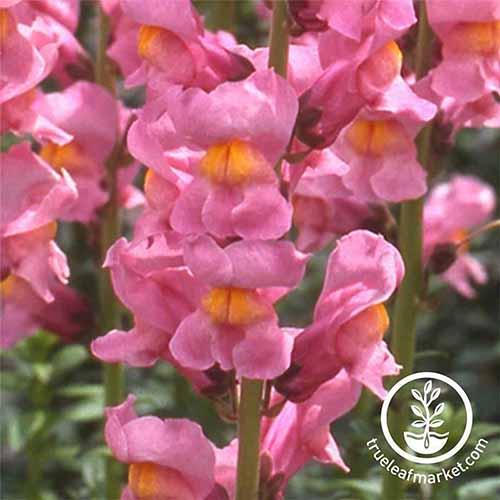
Rocket Series in Rose
Plants grow to mature heights of 30 to 36 inches tall.
You can find seeds in a variety of package sizes available at True Leaf Market.
Snowflake
If you’re a fan of white flowers, ‘Snowflake’ is the cultivar for you, with snowy white blossoms on stems that will reach about 36 inches in height, so they are perfect for cutting.
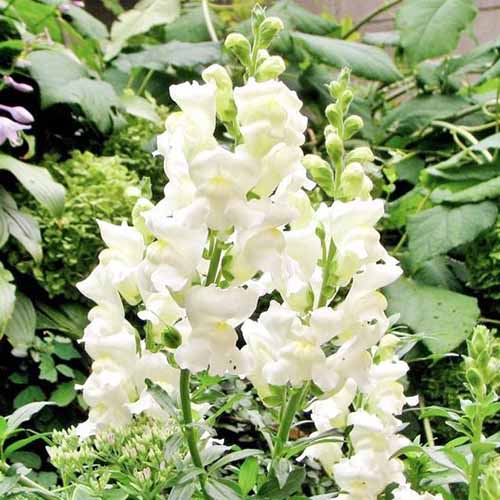
‘Snowflake’
You can find seeds available at Eden Brothers.
Managing Pests and Disease
Even with the best of care, sometimes snapdragons fall victim to pests and disease.
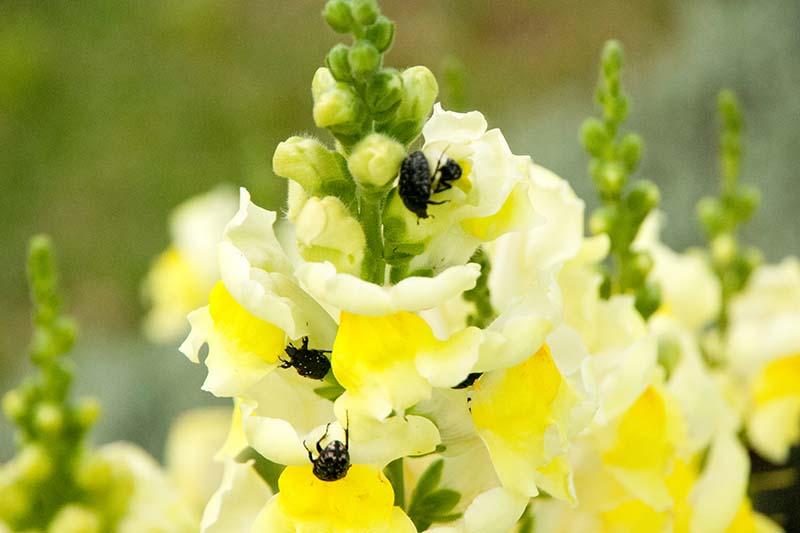
Some insects to be on the lookout for are:
- Aphids
- Cutworms
- Cyclamen Mites
- Leaf Miners
- Spider Mites
Treat plants with organic neem oil for sap-sucking aphids, leaf miners, and mites.
For cutworms, try hand-picking them, physical barriers around plants, or an application of Bacillus thuringiensis (Bt).
As for disease, in addition to rust, caused by Puccinia antirrhini fungi, there are numerous conditions that may present themselves in the presence of overly wet conditions, including:
Damping off is a fungal disease that causes seedlings to flop over and die. There is no cure.
For the other diseases, there are fungicides and nematicides available for treatment.
However, severe infection may require removing plants from the garden and rotating to a new location for future plantings.
Do your best to avoid trouble with preventative measures such as keeping foliage dry, not oversaturating the soil, and maintaining adequate spacing between plants to allow for airflow.
On the upside, hungry herbivores like deer usually have little interest in snapdragons.
Best Uses
Snapdragon adds a rainbow of color to the landscape and attracts a host of pollinators like bees, butterflies, and hummingbirds, that are able to deftly negotiate its tubular blossoms.
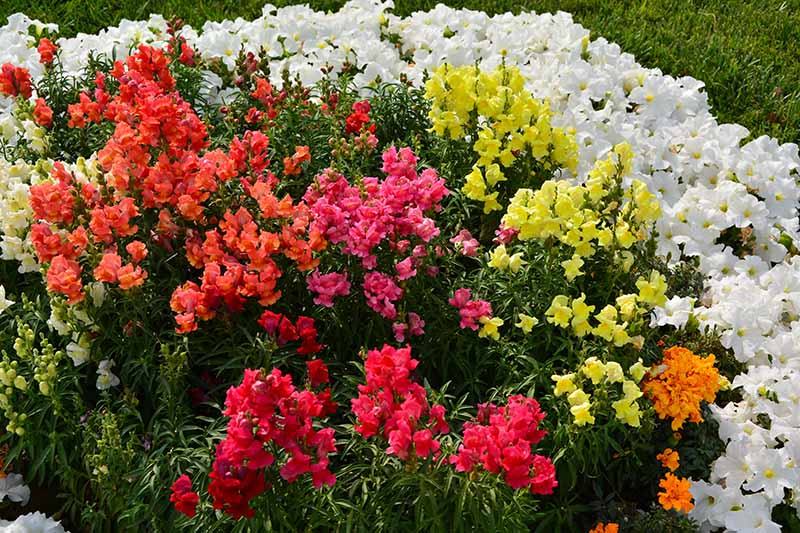
Dwarf varieties are perfect for containers, window boxes, and the fronts of beds and borders.
Intermediate sized plants fill the middle space, between back of bed anchors and low-profile front specimens.
Use the tallest cultivars as anchors behind middle and front flora, where their bold hues and vertical stems ground the arrangement and draw the eye upward.
In the cottage garden, A. majus plays well with marigolds, petunias, and roses in a variety of shades.
And it’s right at home in the cutting garden with cosmos, sweet William, and zinnias, flowers that also come in a stunning array of single and multi-color blooms.
From old-time heirlooms to the latest hybrids, great curb appeal to fabulous flower arrangements, snapdragon makes a bold, structural statement wherever it goes!
Quick Reference Growing Guide
| Plant Type: | Annual, tender flowering perennial | Flower / Foliage Color: | Bicolor, orange, peach, pink, purple, red, tricolor, white, yellow/green |
| Native to: | Mediterranean Europe | Tolerance: | Deer |
| Hardiness (USDA Zone): | 7-10 | Soil Type: | Organically rich |
| Bloom Time: | Spring to frost | Soil pH: | 6.2-7.0 |
| Exposure: | Full sun | Soil Drainage: | Well-draining |
| Spacing: | 6-12 inches | Attracts: | Bees, butterflies, hummingbirds |
| Planting Depth: | Surface sow (seeds) | Companion Planting: | Cosmos, daisies, marigolds, petunias, sweet William, zinnias |
| Height: | 8-36 inches, depending on variety | Uses: | Beds, borders, containers, cottage gardens, cutting gardens, mixed groupings, window boxes |
| Spread: | 6-12 inches, depending on variety | Order: | Lamiales |
| Time to Maturity: | 80-100 days | Family: | Plantaginaceae |
| Water Needs: | Moderate | Genus: | Antirrhinum |
| Maintenance | Moderate | Species: | Majus |
| Common Pests: | Aphids, cutworms, cyclamen mites, leaf miners, spider mites | Common Diseases: | Anthracnose, bacterial leaf spot, Botrytis gray mold, damping off, downy mildew, powdery mildew, root knot nematodes, root rot, rust, Verticillium wilt |
Bold and Structural
Snapdragon, A. Majus, adds vibrant color, velvety texture, and strong, vertical lines to the garden. It stands out prominently and draws the eye pleasingly through mixed groupings.
It’s not hard to grow when you cater to its needs by:
Getting a jump-start in hot summer regions, to allow for blooming during the cool weather it craves.
Avoiding oversaturation to inhibit diseases that thrive on moisture.
Deadheading to promote optimal blooming, and cutting back midseason in all regions, to invigorate plants and stimulate a late-season bloom.
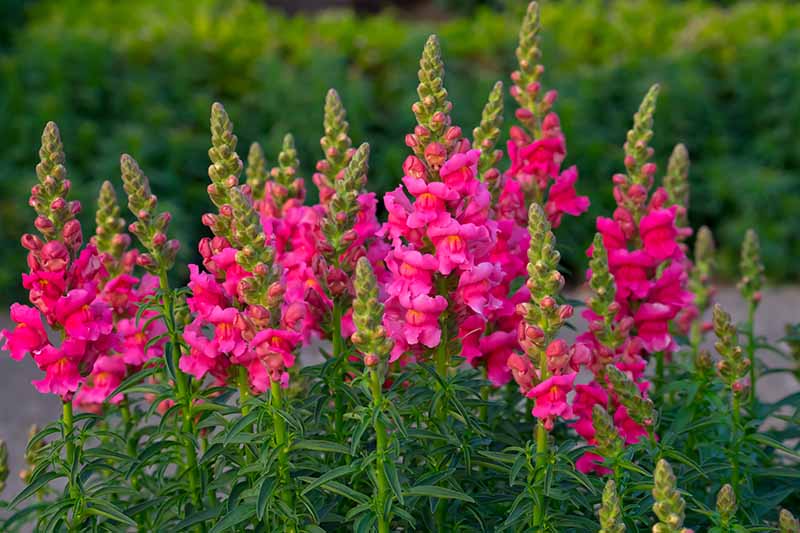
While the gorgeous cultivars are fresh in your mind, it’s time to get out that ever-ready garden planner and make room for snapdragon in this year’s landscape.
Are you growing snapdragons? Feel free to share any cultivation questions you may have with us in the comments section below!
If you enjoyed this guide and would like to read more about growing flowers, we recommend the following articles next:
About Nan Schiller
Nan Schiller is a writer with deep roots in the soil of southeastern Pennsylvania. Her background includes landscape and floral design, a BS in business from Villanova University, and a Certificate of Merit in floral design from Longwood Gardens. An advocate of organic gardening with native plants, she’s always got dirt under her nails and freckles on her nose. With wit and hopefully some wisdom, she shares what she’s learned and is always ready to dig into a new project!

